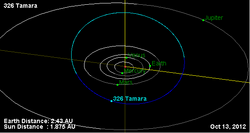Astronomy:326 Tamara
From HandWiki
Short description: Main-belt asteroid
 Orbital diagram | |
| Discovery | |
|---|---|
| Discovered by | Johann Palisa |
| Discovery date | 19 March 1892 |
| Designations | |
| (326) Tamara | |
| Pronunciation | /ˈtæmərə/[1] |
| Named after | Tamar of Georgia |
| Minor planet category | Main belt |
| Orbital characteristics[2] | |
| Epoch 31 July 2016 (JD 2457600.5) | |
| Uncertainty parameter 0 | |
| Observation arc | 122.57 yr (44770 d) |
| |{{{apsis}}}|helion}} | 2.75738 astronomical unit|AU (412.498 Gm) |
| |{{{apsis}}}|helion}} | 1.87764 AU (280.891 Gm) |
| 2.31751 AU (346.695 Gm) | |
| Eccentricity | 0.18980 |
| Orbital period | 3.53 yr (1288.6 d) |
| Mean anomaly | 26.2160° |
| Mean motion | 0° 16m 45.714s / day |
| Inclination | 23.7294° |
| Longitude of ascending node | 32.2069° |
| |{{{apsis}}}|helion}} | 2023-May-19 |
| 238.542° | |
| Physical characteristics | |
| Dimensions | 93.00±1.7 km |
| Rotation period | 14.445 h (0.6019 d) |
| Geometric albedo | 0.0368±0.001 |
| C | |
| Absolute magnitude (H) | 9.36 |
Tamara (minor planet designation: 326 Tamara) is a large Main belt asteroid. It is classified as a C-type asteroid and is probably composed of carbonaceous material. It is the largest member and namesake of the Tamara Family, a 264 million year-old sub-family of the collisional Phocaea family.
It was discovered by Johann Palisa on 19 March 1892 in Vienna and is named after Tamar of Georgia. Name was given by Grand Duke George Alexandrovich of Russia.[3]
References
- ↑ 'Tamarus' in Noah Webster (1884) A Practical Dictionary of the English Language
- ↑ "326 Tamara". JPL Small-Body Database. NASA/Jet Propulsion Laboratory. https://ssd.jpl.nasa.gov/tools/sbdb_lookup.html#/?sstr=326.
- ↑ Schmadel, Lutz D. (2007). "(326) Tamara". Dictionary of Minor Planet Names – (326) Tamara. Springer Berlin Heidelberg. pp. 42–43. doi:10.1007/978-3-540-29925-7_327. ISBN 978-3-540-00238-3.
External links
- 326 Tamara at AstDyS-2, Asteroids—Dynamic Site
- 326 Tamara at the JPL Small-Body Database
 |

